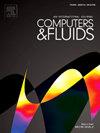A 3D numerical strategy for the computations of shock-induced bubble collapse near a wall
IF 3
3区 工程技术
Q3 COMPUTER SCIENCE, INTERDISCIPLINARY APPLICATIONS
引用次数: 0
Abstract
The importance of modelling two-phase flows involving shock waves arises from many engineering and medical applications. The presence of strong shock waves and their interactions with bubble interfaces, the high density ratio between phases and the large variation of material properties makes the resolution of such problems a complicated task for the numerical methods. While the variety of numerical techniques to solve these problems exist, e.g. the sharp interface or the diffuse interface methods, these strategies can lead to spurious oscillations of the solution near the interface. It is well known that it is difficult to achieve both a high order accuracy of the scheme and the monotonicity of the solution. In this paper a four-equation two-phase model is employed and integrated in an explicit fully parallelised finite-volume solver with HLLC numerical scheme coupled with WENO reconstruction methods and Hancock predictor–corrector scheme and non-uniform mesh based on stretching function in order to compute a 3D shock-induced bubble collapse near a wall. The novelty of our work is improved accuracy of computations of such a problem with optimised computational cost thanks to the non-uniform mesh introduction in 3D computations.
一种计算近壁激波气泡崩塌的三维数值策略
对涉及激波的两相流进行建模的重要性源于许多工程和医学应用。强激波的存在及其与气泡界面的相互作用、高相密度比和材料性能的大变化使得这类问题的求解成为一项复杂的数值方法。虽然存在各种数值方法来解决这些问题,例如尖锐界面方法或扩散界面方法,但这些策略可能导致解在界面附近的伪振荡。众所周知,很难同时达到格式的高阶精度和解的单调性。本文采用四方程两相模型,采用HLLC数值格式,结合WENO重构方法和Hancock预测校正格式以及基于拉伸函数的非均匀网格,将该模型集成到显式全并行有限体积求解器中,以计算三维冲击诱导的壁面气泡崩塌问题。我们工作的新颖之处在于,由于在3D计算中引入了非均匀网格,提高了此类问题的计算精度,并优化了计算成本。
本文章由计算机程序翻译,如有差异,请以英文原文为准。
求助全文
约1分钟内获得全文
求助全文
来源期刊

Computers & Fluids
物理-计算机:跨学科应用
CiteScore
5.30
自引率
7.10%
发文量
242
审稿时长
10.8 months
期刊介绍:
Computers & Fluids is multidisciplinary. The term ''fluid'' is interpreted in the broadest sense. Hydro- and aerodynamics, high-speed and physical gas dynamics, turbulence and flow stability, multiphase flow, rheology, tribology and fluid-structure interaction are all of interest, provided that computer technique plays a significant role in the associated studies or design methodology.
 求助内容:
求助内容: 应助结果提醒方式:
应助结果提醒方式:


